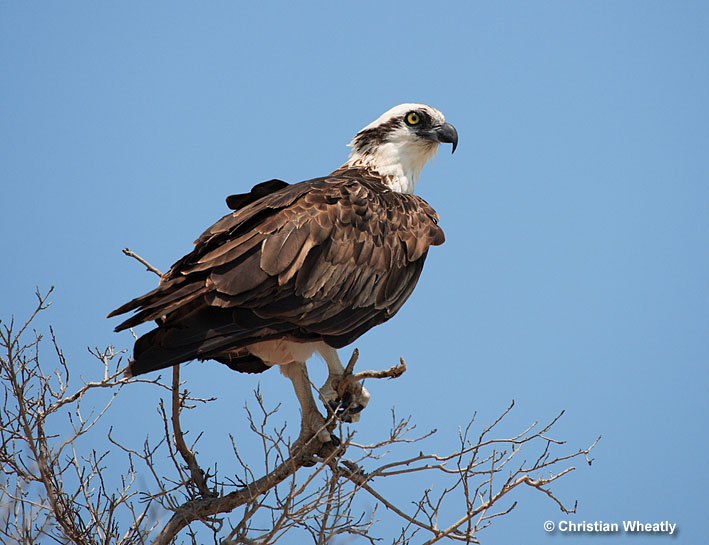The Osprey (Pandion haliaetus), a striking bird of prey, is known for its widespread range, distinctive hunting habits, and unique adaptations.
Found on nearly every continent except Antarctica, Ospreys thrive near shallow bodies of water, preying on fish. You can recognize it by its dark upperparts, white head and underparts, and M-shaped flight shape.
Dive in for some more Osprey facts!
On this page
Identification
Ospreys are slender but large hawks measuring 20-26 inches long with a wingspan of 50-70 inches. They have long, narrow wings with four rather long and one shorter finger-like feathers. In flight, look out for a short tail and M-shaped wings. Depending on their mood or wind direction, the bird may boast a distinctive crest.

Sexes are similar, but female Ospreys are larger and heavier than males. Adults have primarily dark brown to blackish upperparts and white heads and underparts. They have a thick dark line through their eye that extends down their neck, a black strongly hooked bill, yellow eyes, white legs and feet, and black talons.
In flight, look for black patches on their wrists and strongly barred flight feathers and tail. They may also have a dark brown breast band. In male Ospreys, the band is narrower or non-existent altogether. Juvenile Ospreys look similar to adults but have white spotting on their upperside and light buffy wash on the underside.
Vocalizations
Osprey calls may resemble seagull calls. Researchers have identified five different types used for begging, alarm, courtship, nest defense, and keeping in contact. The calls are high-pitched and whistling.
During flight, Ospreys often emit a slow succession of chirps, akin to musical notes. Their alarm calls, piercing and intense, resemble seagull calls and are used to deter potential threats.
Food
The Osprey’s diet is highly specialized, with an astonishing 99% of their food consisting of fish. They prey on over 80 species, generally on those that are 4-12 inches long.
Their preferred prey species varies by region, depending on what is most available.
Common ones include smelt, bullhead, sucker, mullet, flounder, and gizzard shad. If fish are scarce, they resort to hunting small birds, mammals, amphibians, or reptiles.
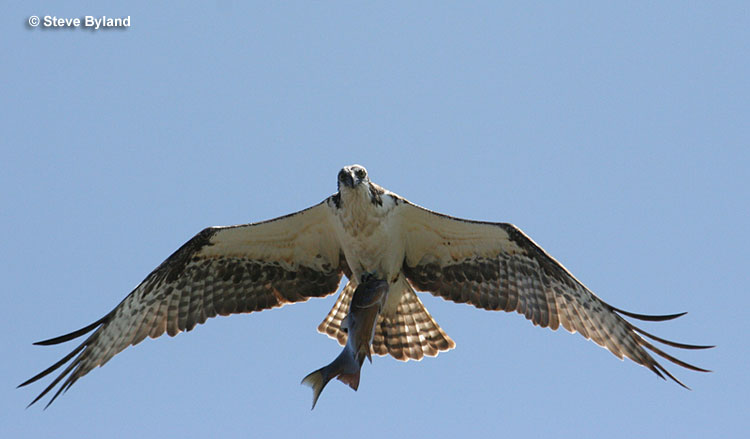
Ospreys prefer to hunt on the fly rather than from a stationary perch. They soar 30-130 feet above the water, scanning the surroundings for fish.
When the bird spots its prey, it hovers briefly before executing a dramatic dive. Just before striking the surface, it shifts its legs forward and snatches the fish into its talons, often repositioning it for greater aerodynamic efficiency.
The Osprey then transports the fish to a nearby perch, often in proximity to the nest, where it proceeds to consume its meal, typically head first. They do not cache food, nor do they generally need to drink water.
Nesting and Eggs
Ospreys may nest in solitude or in loose colonies, depending on where and how suitable nesting sites are clustered. They are generally monogamous although in rare instances when nests are close together, one male may care for two females and nests.
Courtship in Ospreys revolves around two vital aspects of their lives: food and nesting sites. The courtship process often begins with the male performing aerial displays near his chosen nest site.
Once a pair has established their nest, the male assumes the responsibility of providing food for the female. This act of food delivery is not just a gesture of nourishment but an important courtship aspect. Well-fed females are generally more receptive and less likely to copulate with other males.
Osprey nests are big, 2.5-6 feet in diameter, and can be found in treetops, snags, crotches between large branches and trunks, and on cliffs, somewhere with open surroundings. Both the male and female actively collect materials for the nest, but the bulk of the building process falls on females.
The nests are bulky, constructed primarily from sticks and lined with softer materials like seaweed, kelp, grasses, and even odd items like fishing line and plastic bags. Ospreys may reuse and repair the same nest from year to year.
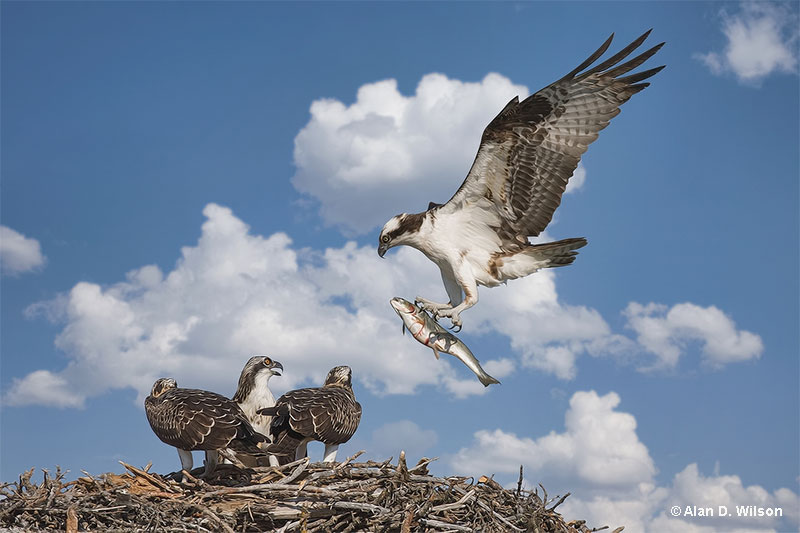
These raptors have only one brood per year with 1-4, generally 3 eggs in a clutch. Osprey eggs are creamy white to light cinnamon, heavily blotched with brown. They measure 2.2-2.7 inches long and 1.6-2 inches wide.
Both parents, but mostly the female incubates the eggs for 36-42 days. Females brood and feed the young while the male provides food. Offspring fledge at 48-59 days and become independent about a week to eight after that.
Current Situation
Ospreys range throughout all the continents except for Antarctica, and they have four subspecies. In North America, there is only one subspecies – Pandion haliaetus carolinensis.
They breed in Canada and the United States and fly south to Central and South America for the winter. Some Ospreys are permanent residents in parts of the southernmost United States, such as California and Florida.
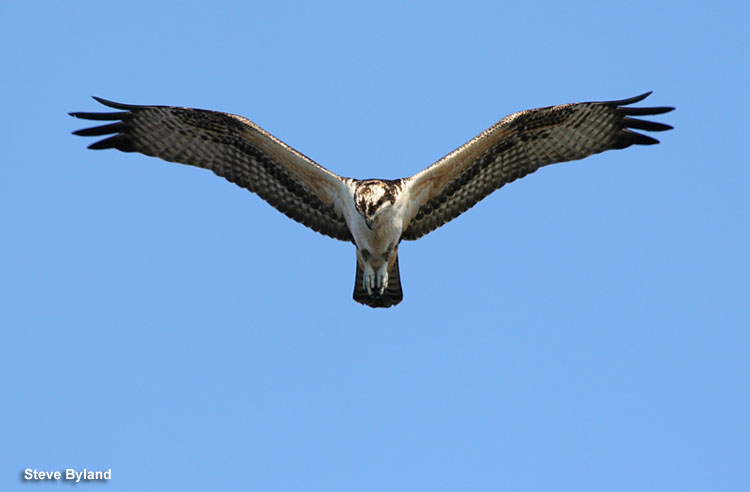
Osprey habitats are always near a body of water. They prefer shallow waters with an abundance of prey and places with suitable nesting sites. Some of these places include salt marshes, rivers, swamps, bogs, reservoirs, lakes, and coastal areas.
Ospreys are listed as of least concern on the IUCN Red List since they are widespread and numerous species overall. Its population is increasing.
Facts
- Ospreys have several remarkable adaptations that enable them to excel in hunting fish. They have reversible outer toes, closeable nostrils that prevent water from entering, feet with backward-facing scales to better grip fish, and dense oily plumage to avoid getting soaked.
- Ospreys are successful hunters with at least 24% and up to 74% of their dives being successful. They’re most successful with calm weather at mid-tide.
- Ospreys are also called river hawks, sea hawks, and fish hawks. Its Latin origin (avis praedae) means “bird of prey”.
- In the wild, Ospreys typically live for 7-10 years. The oldest wild Osprey on record lived in Europe and lived over 30 years old.
- Ospreys, like many other raptors, are connected to power, strength, and good luck. In some cultures, they also symbolize healing, regeneration, and the sun.
- Seattle Seahawks, the famous NFL team, is named after Ospreys.
Similar Species
Ospreys are rather large and unique birds of prey. There are still some species that look similar, but due to some distinguishing features it shouldn’t be too hard to tell them apart.
Bald Eagle
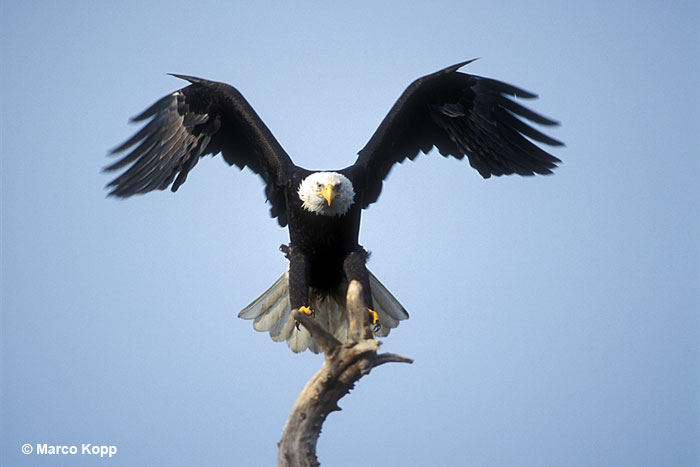
In North America, Bald Eagles have a similar range and inhabit similar areas. Adult Bald Eagles have stocky dark bodies, dark, broad, and rounded wings, white heads and necks, white tails, and yellow feet and bills. Juvenile Bald Eagles are dark brown all over with white mottling.
If you compare a Bald Eagle with an Osprey, then Bald Eagles are larger, stockier, and have broader wings.
Adult Bald Eagles have uniformly dark bodies and underwings and white heads and tails whereas adult Ospreys have white undersides with barred flight feathers and tail and dark wrist patches. Ospreys also have a dark bill instead of a yellow one. Juvenile Bald Eagles are also mottled underneath, but they have a much darker body.
Red-tailed Hawk

Red-tailed Hawks have a similar range to Ospreys, but they are resident in most of the US. They have many different subspecies, but the one similar to Ospreys has a mostly white underside, a dark belly band, small brown patches on the wrist, dark edges to the flight feathers, and a red tail.
Compared to an Osprey, Red-tailed Hawks have broader wings, and they hold them straight while in flight as opposed to the M-shape the Ospreys create. They have paler undersides whereas Ospreys have darker flight feathers and lack the red tail.
Frequently Asked Questions
Why is it called an Osprey?
Osprey’s name comes from the Old French “osperit”, which in turn has been derived from the Latin “avis praedae” that translates to “bird of prey”.
Is Osprey an eagle or a hawk?
Osprey is a hawk.
What is so special about Osprey?
Ospreys are 99% piscivorous and have several remarkable adaptations, including reversible outer toes, closeable nostrils, dense oily plumage, and feet with backward-facing scales.
Is it rare to see an Osprey?
It is rare to see an Osprey. They are most commonly found near bodies of water.
What is the prey of Osprey?
Ospreys prey almost exclusively on fish, which is why they are sometimes called Fish Hawks.

